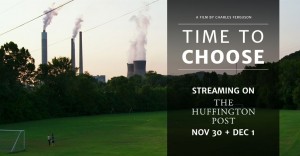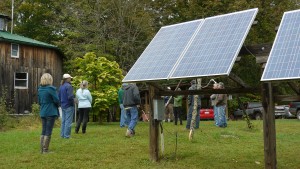- Like
- Digg
- Del
- Tumblr
- VKontakte
- Buffer
- Love This
- Odnoklassniki
- Meneame
- Blogger
- Amazon
- Yahoo Mail
- Gmail
- AOL
- Newsvine
- HackerNews
- Evernote
- MySpace
- Mail.ru
- Viadeo
- Line
- Comments
- Yummly
- SMS
- Viber
- Telegram
- Subscribe
- Skype
- Facebook Messenger
- Kakao
- LiveJournal
- Yammer
- Edgar
- Fintel
- Mix
- Instapaper
- Copy Link
Disclaimer first: since I have friends in and am a member of OVEC, which helped with the filming of the coal piece, I could have a positive bias as I write this review of Time to Choose.
 On the other hand, the reading I do on issues of environmental justice, peak oil and resource depletion, and the many people discussing solutions to the intertwined crises facing humanity makes me conscious of all the things Time to Choose left out. Perhaps omissions are unavoidable, if you want to cover the world’s problems within an hour and a half in sufficient depth and with sufficient imagery to engage the viewer. I would say the film succeeded there; my attention never flagged. The music was unobtrusive, the visuals arresting and the spokespeople well-chosen. Dividing the problem into three parts worked well, too.
On the other hand, the reading I do on issues of environmental justice, peak oil and resource depletion, and the many people discussing solutions to the intertwined crises facing humanity makes me conscious of all the things Time to Choose left out. Perhaps omissions are unavoidable, if you want to cover the world’s problems within an hour and a half in sufficient depth and with sufficient imagery to engage the viewer. I would say the film succeeded there; my attention never flagged. The music was unobtrusive, the visuals arresting and the spokespeople well-chosen. Dividing the problem into three parts worked well, too.
The first segment was about coal and electricity, and it led off with West Virginians talking about mountaintop removal coal mining and its harm to local ecosystems and the health and well-being of those living nearby. It also showed images of Chinese mines, where the safety of miners and the health of those exposed to coal-smog are many magnitudes worse than here.
And then it showed how solar and wind power have come down in price until they’re competitive with fossil fuels over most of the world. We see massive renewable energy farms as well as household solar panels, both in the developed world and in the poorest parts of Africa and India.
So what was left out here? First of all, the similar harms both globally and locally from gas-derived electricity; and the different problems with nuclear power. Secondly, a realistic discussion of the environmental costs of renewable energy, which are not zero. For one thing, it takes a great deal of energy to produce solar panels and the steel for windmills; will we actually increase emissions while creating the infrastructure for a transition? We obviously can’t afford to keep on with business as usual, but averting catastrophic climate change may require more than a substitution of fuel source; we also have to look at serious efficiency and conservation measures.
The second section looked at the transportation sector and the harm from the oil industry. The proposed solution was mainly electric cars. But I’ve seen claims that half the energy a car will use is in its manufacture… we really can’t afford to just replace all our cars, including the millions going every year to first-time drivers in China and India, with electric models. The film did also show smart public transport (Brazil) and a biking culture (Holland). But I think we’ll have to end the arrangements wherein it’s normal to drive several miles daily between work and home, and this is not a simple matter.
The third section, on agriculture and deforestation—which are intimately connected as most deforestation is for the sake of clearing land for agriculture—was also over-simplified, suggesting that the reduction or cessation of meat-eating would solve the problem. Certainly a lower level of meat-eating would help, but there are worse culprits in the diabetes epidemic mentioned, and I have read convincing claims that carefully managed pastures, often as part of a multi-cultural system, can actually help sequester carbon. But the film did show that organic agriculture, in mixed systems, can be a healthy solution for climate, consumers and the farmer.
The basic message of the film is that we already have the solutions, and implementing them will not only avert the worst degree of climate change and reduce other environmental harms, but also improve economies, and generally create a better world. But can this truly be done without cutting our numbers? Can we maintain an economic system dependent on endless growth and somehow achieve sustainability? More to the point, can we even make the more limited transitions advocated in the film without somehow triumphing over the ubiquitous corruption that puts the further enrichment of billionaires ahead of all else?
As we will surely see when the Paris conference leads to an inadequate agreement long on spin and short on enforceability and justice, the problem is that nearly all the world’s governments are owned by the world’s corporations. Yes, there are practical, currently available technologies to solve each problem, but if we can’t make changes that threaten corporate profits, it doesn’t help to have the technical solutions. Climate change is more a political problem than a technical one.
 But the film does point to changes already happening, and things we can do to be part of the solution: look into getting solar power (there are co-ops forming in WV’s major cities, to bring the price down; check out WVSUN); use a bike or your feet for short trips, get a hybrid or electric car if you must have a car; eat less meat and seek out locally and organically grown food or grow some of your own; speak up in defense of the Clean Power Plan, and against the TPP and TTIP which would cement corporate veto power over desperately needed legislation.
But the film does point to changes already happening, and things we can do to be part of the solution: look into getting solar power (there are co-ops forming in WV’s major cities, to bring the price down; check out WVSUN); use a bike or your feet for short trips, get a hybrid or electric car if you must have a car; eat less meat and seek out locally and organically grown food or grow some of your own; speak up in defense of the Clean Power Plan, and against the TPP and TTIP which would cement corporate veto power over desperately needed legislation.








